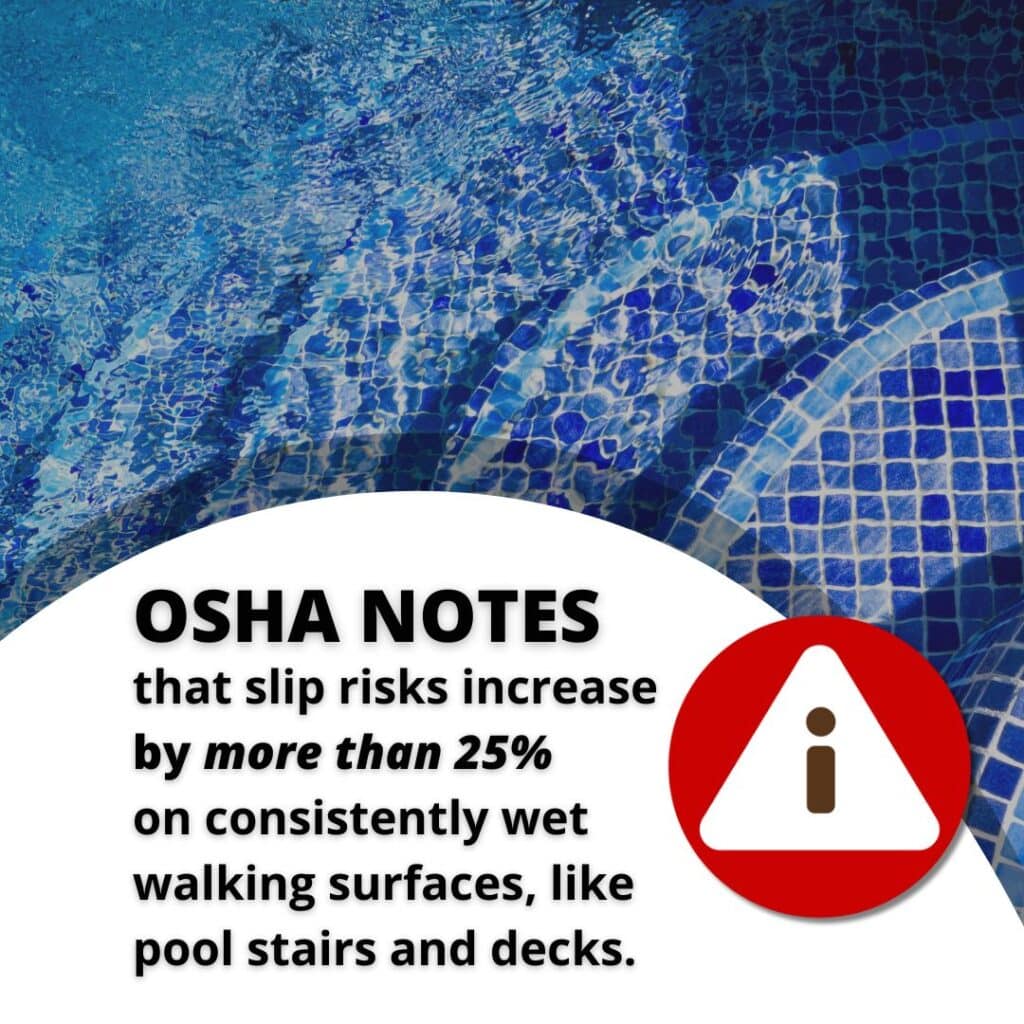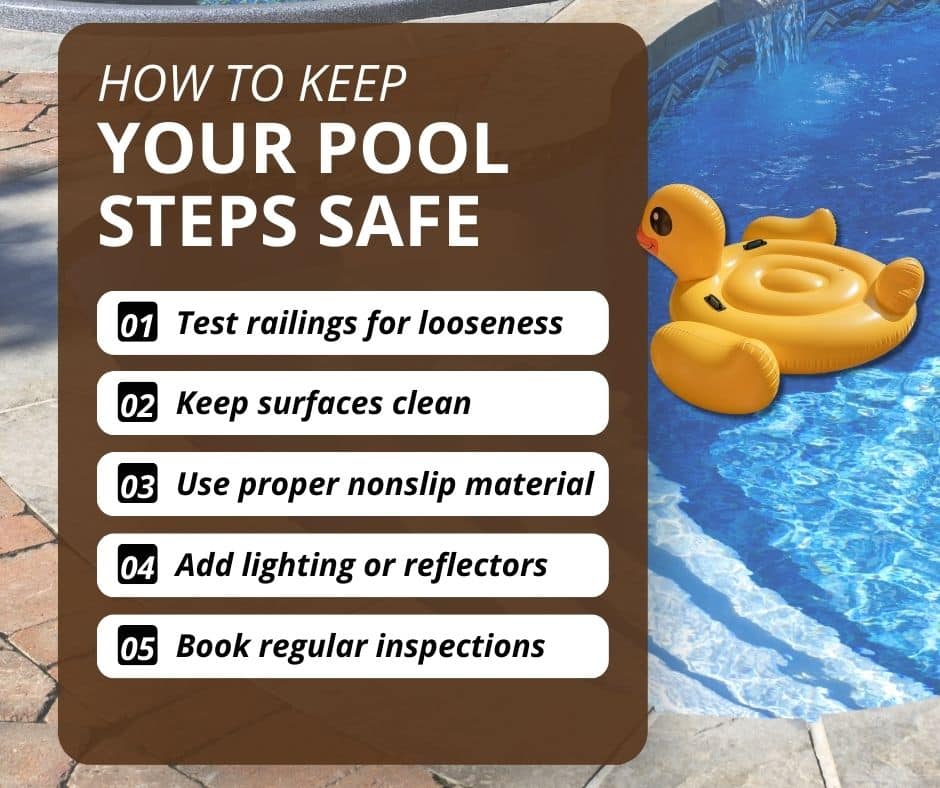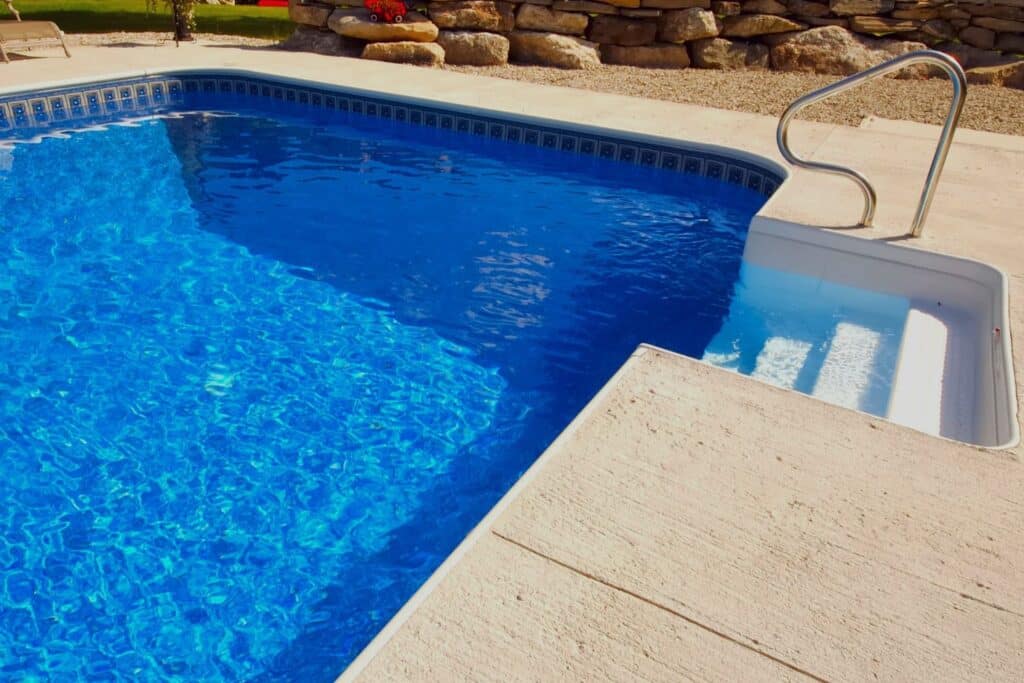When it comes to pool safety, most people think about fences, gates, and water depth, but many overlook the nearby staircase.
Whether you’re buying a home with a pool, preparing to list yours, or just doing routine maintenance, it’s worth taking a closer look at your pool’s steps. What might seem like a minor detail can actually be a safety hazard, especially if the structure is aging or wasn’t installed properly.
In this post, we’ll break down what makes pool staircases risky, how inspectors evaluate them, and what homeowners can do to reduce liability and increase safety.
Why Pool Staircases Are Often Overlooked
Pool staircases are used every time someone enters or exits the water, yet they often go unnoticed compared to other important elements like pool fences, covers, or depth.
Because steps are constantly submerged, exposed to pool chemicals, and sometimes hidden beneath surface water, small problems are easy to miss until they create a hazard.
Homeowners may not realize there is an issue until a step feels unstable, algae makes the surface slick, or a handrail comes loose. These problems may seem minor, but they can quickly turn into accidents.
The scale of the risk is larger than many expect. Each year, around 155,000 injuries occur in or around swimming pools in the U.S., many due to slips and falls. Stairs and ladders are a major part of that statistic because they are high-use access points.
In short, staircases play a critical role in safe pool use, but they remain one of the most commonly neglected features in residential pool maintenance.

What Makes a Pool Staircase Unsafe?
A pool staircase doesn’t need to look broken to be dangerous. Below are some of the most common defects we encounter during home inspections.
1. Loose, Cracked, or Wobbly Steps
Pool stairs made of fiberglass, plastic, or concrete can develop cracks over time. Some cracks are cosmetic, but others allow water to seep into the structure. This can cause instability or even collapse if ignored.
Stairs that flex or shift under weight may indicate weakened anchors or poor installation. This is especially common in older in-ground pools and above-ground models with bolt-on stairs.
2. Slippery or Worn Surfaces
Pool stairs should have a non-slip surface, but that coating can wear off. Algae buildup or smooth fiberglass increases the chance of slipping.
Homeowners often try to fix this with stick-on treads, but if they aren’t pool-rated, they may peel off underwater.
3. Missing or Insecure Handrails
Handrails are critical for balance and accessibility, especially for children and seniors. If a handrail is missing, rusted, or feels loose when pulled, it fails to provide the support it’s meant to.
4. Uneven Step Height or Poor Visibility
Stairs that are different heights or depths can confuse swimmers and increase the risk of falling. This is even more dangerous in murky water or pools without proper underwater lighting.
Experts recommend clear markings for pool depth transitions, including where stairs begin. Unfortunately, many residential pools lack this visibility.
How Inspectors Evaluate Pool Staircases
At Champia Real Estate Inspections, we treat pool staircases like any other structural or safety-critical feature. That means we evaluate more than just how they look. We check:
- Step integrity: Are there cracks, chips, or visible flex points under pressure?
- Grip and traction: Do the steps provide enough surface resistance, even when wet?
- Anchoring systems: Are stairs secured properly to the pool wall or deck?
- Handrails and hardware: Are rails present, rust-free, and stable under load?
- Surrounding materials: Is the deck around the staircase level and in good condition?
- Safety compliance: Does the setup follow current pool safety guidelines and standards?
We also document any visible mold or algae growth, improper repairs, or step modifications that may cause concern during a real estate transaction. These issues may affect insurance, liability, or pool usability.
Why This Matters for Buyers and Sellers
If you’re buying a home with a pool, the condition of the staircase is a safety and financial concern. Stair damage can point to broader maintenance issues and may require repair or replacement before you feel comfortable using the pool.
For sellers, addressing staircase safety before listing helps avoid problems during inspection. It also improves buyer confidence. According to Realtor.com, homes with well-maintained pools typically have higher buyer interest, but only if the pool looks safe, usable, and properly cared for.
In some cases, a poorly maintained staircase can be enough to scare off buyers, especially those with children or older adults in the household.

Tips for Making Your Pool Staircase Safer
You don’t need a full renovation to improve safety. In many cases, simple upgrades or maintenance can reduce risk significantly.
Check for loose steps regularly by applying gentle downward pressure with your foot. If the stairs shift or creak, they may need reinforcement or replacement.
Keep surfaces clean and textured. Scrub away algae and apply a pool-safe anti-slip coating to fiberglass or vinyl steps. Replace worn treads as needed.
Install or tighten handrails. Handrails should be securely anchored into the deck or pool wall and be able to support full body weight.
Improve visibility. Use LED pool lighting or reflective stair edging so swimmers can clearly see each step, even at night or in deep water.
Schedule a professional inspection. If your pool is older, newly inherited, or part of a real estate transaction, a licensed inspector can assess the condition of your entire pool system, not just the stairs.
Other Questions Homeowners Are Asking
Do pool staircases have to meet standards?
In most areas, yes. Local building standards and pool safety regulations may require specific tread depth, riser height, and handrail placement.
Can loose pool steps be repaired, or do they need to be replaced?
It depends on the material and the cause of the damage. Minor cracks or wobbles may be fixed with brackets or patch kits, but deeper damage may require replacement.
Are pool stairs covered in a typical home inspection?
Not always. Some inspectors skip pools unless specifically requested. At Champia, we offer assessments of pool and spa areas that include stairs, decks, fences, and all mechanical equipment.
Is this something I can fix myself before selling?
Some issues, like loose railings or algae cleanup, are DIY-friendly. But structural concerns or full replacements should be handled by a pool technician or inspector.
When to Call a Professional
If your pool stairs feel loose, slippery, or just look worn down, don’t assume it’s no big deal. These small issues can lead to real injuries, especially for kids, seniors, and guests who may not be familiar with the pool.
A professional inspection can help you understand whether the stairs are still safe, what needs to be repaired, and how to fix it before it becomes a liability. At Champia, our inspectors are trained to spot hidden hazards and give you a full picture of your pool’s safety and condition.
Conclusion
Pool staircases may not get much attention, but they should. A safe, stable, and visible set of steps protects everyone who uses the pool.
Whether you’re buying, selling, or staying put, maintaining and upgrading your home’s major systems is one of the easiest ways to improve safety and avoid future problems. Book your inspection today.
